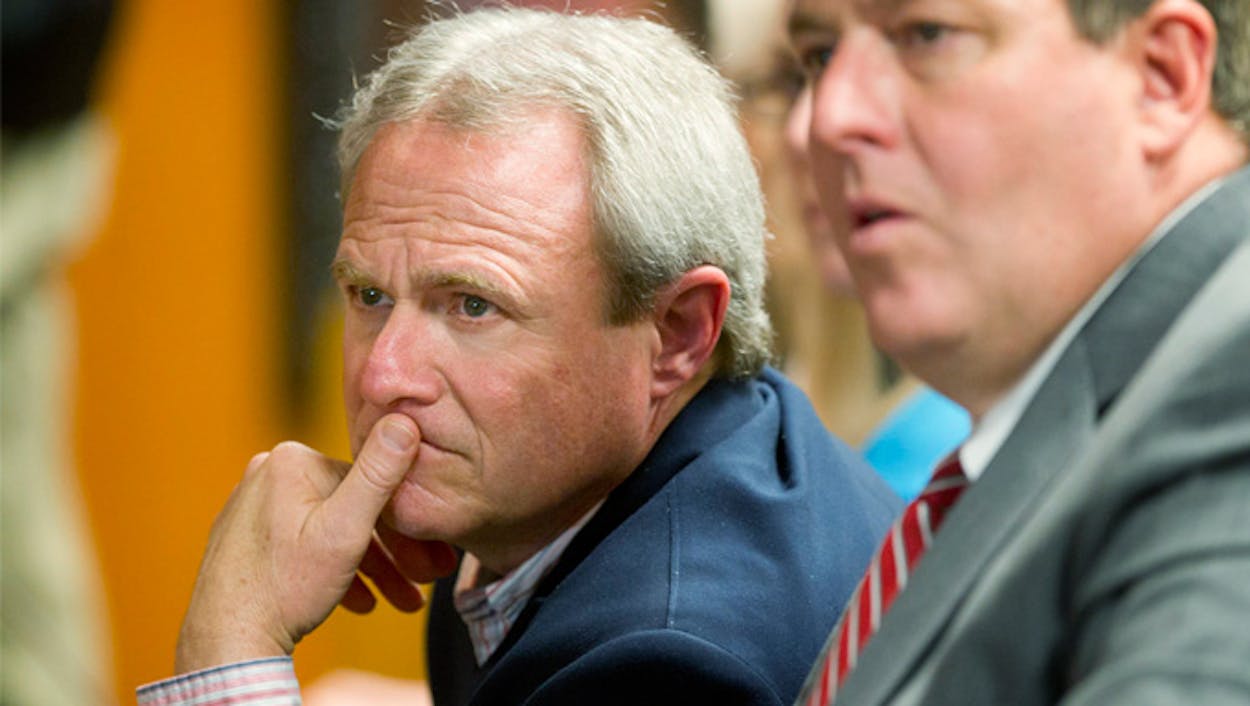This week, the next chapter of one of Texas’s most unsettling murder cases will be written. As I chronicled in last year’s two-part article “The Innocent Man,” Michael Morton was wrongly convicted of murder and sentenced to life in prison after his wife, Christine, was bludgeoned to death in their Williamson County home in 1986. Michael, an Austin grocery store manager, always insisted he was innocent. Then, in 2011, DNA testing of a bandana that was found near the crime scene identified an unknown man’s biological material intermingled with Christine’s blood. The DNA was later identified as that of drifter Mark Alan Norwood. Michael was subsequently exonerated and freed after nearly 25 years in prison. Norwood was arrested and will be tried for Christine’s murder this March.
First, though, a different sort of legal proceeding will take place—one that will essentially put Ken Anderson, the former Williamson County D.A. who prosecuted Michael, on trial. Starting on Monday, Anderson will be the subject of a “court of inquiry,” an arcane legal procedure unique to Texas that can be used to investigate wrongdoing, most often on the part of state officials. It has never been used before to probe allegations of prosecutorial misconduct. The unprecedented legal proceeding will try to determine whether Anderson withheld critical evidence from Michael’s defense attorneys which would have helped Michael prove his innocence more than a quarter-century ago.
Anderson is now a state district judge. That a former prosecutor, much less a sitting judge, will face such intense scrutiny is remarkable. Prosecutorial misconduct rarely results in even disciplinary action from the Texas bar. But if the presiding judge in the court of inquiry finds probable cause to believe that Anderson broke the law, he will face criminal charges and a warrant will be issued for his arrest.
The court of inquiry came about after Michael’s lawyers conducted an extensive investigation in the fall of 2011 that suggested Anderson had not disclosed exculpatory evidence to the defense. That evidence included a transcript of Michael’s mother-in-law informing an investigator that her three-year-old grandson had told her he had witnessed the murder, and that “a monster”—not his father—had beaten his mother to death. Other evidence that was in the state’s possession but was unknown to the defense included a police report that Christine’s credit card had been used in San Antonio two days after her murder. Another report described neighbors’ sightings of a man in a green van around the time of the crime.
The court of inquiry will function essentially as a grand jury, in that it will determine if criminal charges should be brought. But unlike a grand jury, it will be conducted in open court. There will be no jury, only a judge. And Anderson’s legal team can present evidence and cross-examine witnesses. A visiting judge from Fort Worth, state district judge Louis Sturns, has been appointed by the Texas Supreme Court to oversee the inquiry. Legendary defense attorney Rusty Hardin will serve as the “attorney pro tem” who will present witnesses and evidence to help Sturns “determine if an offense has been committed,” according to the Code of Criminal Procedure. The unusual proceeding will be held in Georgetown, at the Williamson County Justice Center, just down the hall from Anderson’s courtroom.
Anderson’s attorneys will likely argue that their client did not know about all of the evidence that was contained in the files of the late Williamson County sheriff, Jim Boutwell. Their arguments will be based on a narrow reading of what a prosecutor’s legal obligation is to turn over exculpatory evidence. They will no doubt argue that the statute of limitations has long since expired on any possible misconduct. Michael’s lawyers at the Innocence Project, however, have previously suggested that the four-year window during which a prosecutor can be charged for misconduct has not yet closed because Anderson committed an ongoing act of “fraudulent concealment” during Michael’s incarceration.
Of the nearly two dozen witnesses who may take the stand, I’ll be the most interested to hear from two people. One is Mike Davis, the former assistant D.A. who helped Anderson prosecute Michael in 1987. The other is John Bradley, who recently stepped down as Williamson County’s district attorney. For five years, Bradley vigorously fought Michael’s attempts to have DNA testing performed in the case. Bradley, by his own admission, was consulting with Anderson—his predecessor and mentor—during that time. I’m also expecting to hear interesting testimony from Kimberly Dufour Gardner, a prosecutor who worked in the DA’s office in the mid-eighties, who wrote an affidavit in 2011 stating that Anderson had voiced his doubts about Michael’s guilt even after his arrest.
I’ll be in Georgetown covering the hearing, so check back for updates throughout the week.






